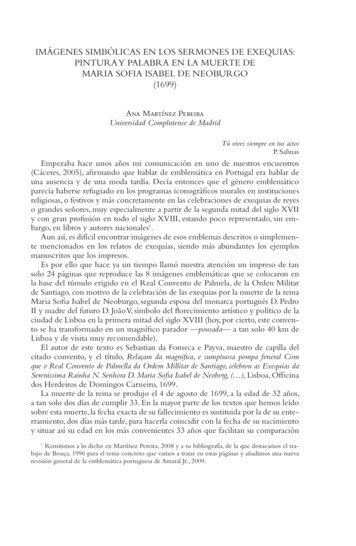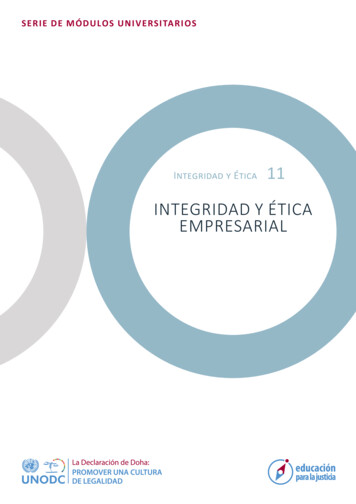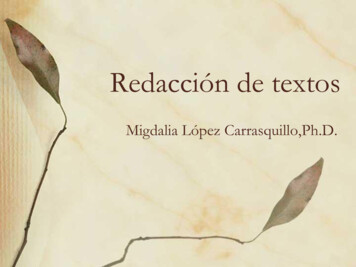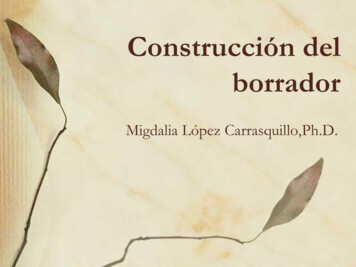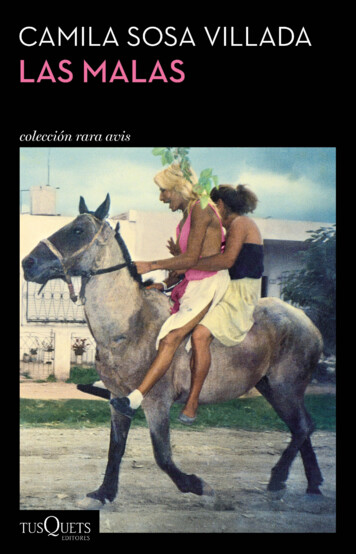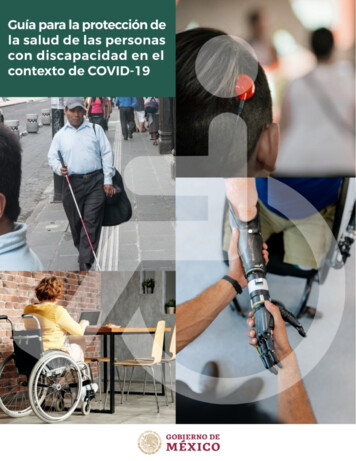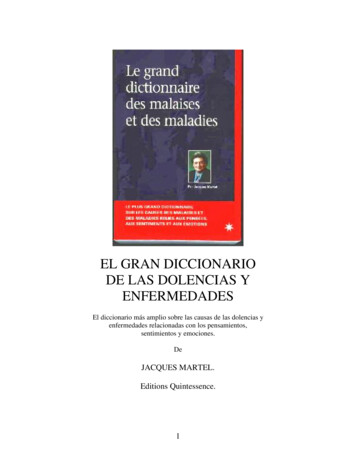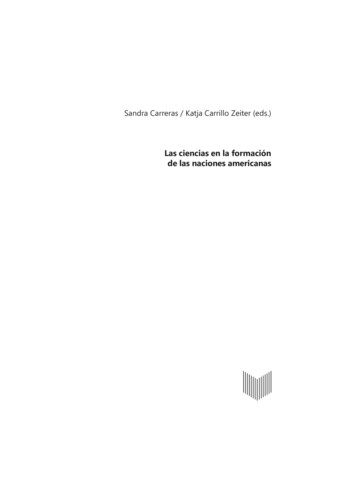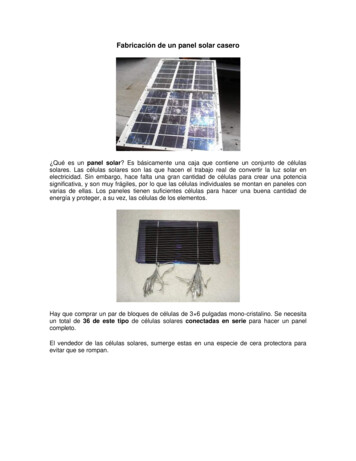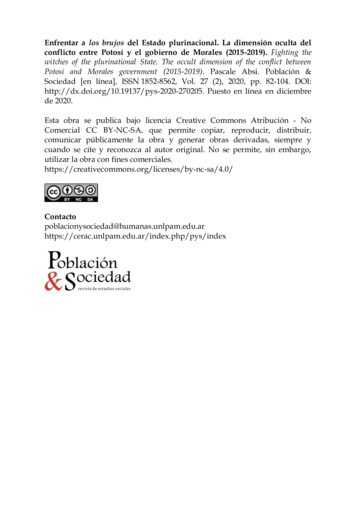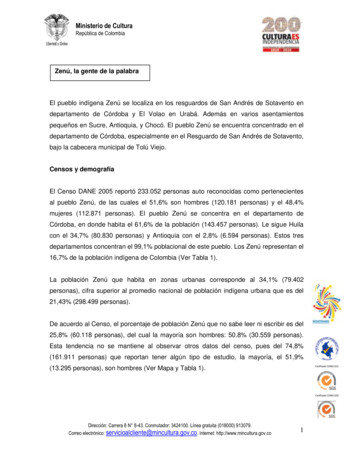
Transcription
LasLas t.Youmaychoosetoreadthemonyourown,oryourenjoyment. You may choose to read them on your own, or bratingreligiousindigenous, and African cultures. Holidays celebrating atareimportantholidays commemorate events or people that are customsthatdifferbetweencountries.have traditions and customs that differ between mportantholidaysandhowtheySpanish-speaking world celebrates important holidays and how ditions.CelebracionesCelebraciones
ContenidoAgosto: Feria de Málaga . . . . . . . . . . . . . . C2Septiembre: Día de la Independencia. . . . . . . . C4Octubre: El 12 de Octubre . . . . . . . . . . . . . C6Noviembre: ¡Día de los Muertos! . . . . . . . . . C8Diciembre: Las Navidades . . . . . . . . . . . . . C10Enero: ¡Año Nuevo! . . . . . . . . . . . . . . . . C12Febrero: ¡Carnaval! . . . . . . . . . . . . . . . . C14Marzo: Las Fallas. . . . . . . . . . . . . . . . . . C16Abril: Semana Santa . . . . . . . . . . . . . . . . C18Mayo: ¡Cinco de Mayo! . . . . . . . . . . . . . . C20Junio: Inti Raymi . . . . . . . . . . . . . . . . . . C22Julio: Día de Simón Bolívar . . . . . . . . . . . . C24CelebracionesC1C1
Feria de MálagaObjectives Provide background for the topic: Feriade Málaga Familiarize students with the origin ofthe Feria de Málaga and its traditions.Presentation Strategies20-minute lesson Ask students to locate Spain and Málagaon a map. Have students read the pages about Feriade Málaga. Have small groups discuss theComparación cultural questions.50-minute lesson Complete 20-minute lesson. Have students preview the pictures toidentify ways Feria de Málaga iscelebrated. (music, food, dancing, rides) Introduce the Vocabulario para celebrarand pronounce the English and Spanishterms. Ask students to use math to determinehow many years ago Ferdinand andIsabella entered Málaga. (Subtract 1487from the present year.) Ask the groups to summarize theirdiscussions for the class.Feria de MálagaLa Feria de Málaga celebrates King Ferdinand and Queen Isabella’striumphant entrance into the coastal city of Málaga on August 19, 1487.The pair claimed the city for the crown of Castile, an event this Spanishcity has been celebrating for over 500 years. The Feria de Málaga now lastsfor nine days and takes place in two parts of the city. Each day at noonthe downtown fills with fairgoers. In the Real, a separate fairground,participants in flamenco dress or riding clothes ride on horseback or inhorse-drawn carriages, or stroll, in a tradition known as el paseo. ThisFeria de caballos Moredaytime feria unfolds against a backdrop of music, singing, and dancingthan a thousand ridersand over a hundredand ends at 6:00 p.m., when everyone goes home to rest. The celebrationhorse-drawn carriagesstarts again at night in the Real and continues into the early morningand Notecarts to Edit: Need a Pacing Suggestions Boxwithlinktospecificunitand lessonthatrelateshours.For thisnightlyferia, people gather in public and private tvocabulary,in el paseo.to enjoy concerts, theatrical presentations, music,Link to Unit Grammardance, and food. The last night of the feria endswith a city-sponsored concert followed by aspectacular fireworks display.S TA N D A R D S2.1 Practices and perspectives2.2 Products and perspectives4.2 Compare culturesMúsica callejera Musicians play in the streetsduring the feria. Here a panda, or group, playsverdiales, traditional music that featuresguitars, tambourines, and tiny cymbals.ConnectionsSocial StudiesUse a world map or map of theMediterranean area (pp. xxxviii–xxxix, xliii). Help students locate the country of Spainand the city of Málaga on the map, pointingout that Málaga is a coastal city on theMediterranean Sea. Tell students that Málaga is the capital cityof the province (similar to an Americanstate) also named Málaga. Explain that Málaga is an important port city.Encourage students to investigate the goodsexported from and imported to the city.C2C2CelebracionesBridging Culturesav10l1se fmho01 C2-C3.indd C22/28/09 11:34:1av1Heritage Language LearnersEnglish LearnersRegional Variations Some words in thisIncrease Interaction Many of the Englishterms in the lesson may be unfamiliar tostudents. Encourage groups to find or drawpictures to illustrate the terms. Have thempost each picture on a card and write theEnglish term it illustrates. Have students workwith partners to review the vocabulary usingthe cards.mini-lesson have multiple or regionalmeanings. For example, feria can mean smallchange in Mexico and tip or gratuity in CentralAmerica. Help students identify the meaningof the word as used in the mini-lesson byproviding several context sentences in whichthey insert the word. Do this for words suchas real and feria.
Feria de MálagaSee these pages come alive!CultureAbout the PhotosEntranceway Encourage students to analyzethe left-hand photograph on page C3. Pointout that the entranceway depicts importantparts of the culture of Málaga. Encouragestudents to list soccer ball, fans, guitar, fish,and flowers and relate them to the culture.Point out the name Picasso. If necessary,explain that Picasso was one of the mostimportant artists of the 1900s. Ask studentsto infer why Picasso would be mentioned onthe entranceway and to do research to verifytheir inference. (Picasso was a native son ofMálaga, born on October 25, 1881.)Gratis Have students read the sign in the top,right-hand photograph and the caption.Have students find, share, and comparerecipes for paella. Explain that there aremany variations on the recipe but mostinclude seafood and rice.Una caseta offers free samples of paella,a rice and seafood dish that is a regionalspecialty from the coastal cities of Spain.Bailando flamenco Fairgoers performfolkloric dances such as flamencoand sevillanas in the streets, plazas,and casetas, wherever there is music.Una entrada a la feria Riders pass in frontof one of the decorative entrances to astreet in the historic downtown of Málaga.Vocabulario para celebrarlos caballoslas carretaslas casetasla feriael paseohorseshorse-drawn carriagessmall houses or tentsfaira walk, stroll, or ride1. Does your town or city celebrate its beginnings or inauguration as a community,or is there a special “town day”? What events take place during the celebration?2. What events in your community or region are similar to those of the Feria de Málaga?Describe them and then compare them to the Feria de Málaga.CelebracionesC3Possible AnswersEnrichment10l1se fmho01 C2-C3.indd C33/1/09 5:48:14 AMArts and CraftsMusicEntranceway Decoration Have studentsexamine the photograph of the entrancewayon page C3. Tell students to imagine they areon a committee in charge of designing anentranceway for a holiday and a city of theirchoosing. Have them work in small groups tocreate the design. Have them post theirdesigns on a bulletin board.Sevillanas and Flamenco Play traditionalsevillanas or flamenco music and havestudents describe the music. You mightarrange for a video demonstration of thesefolk dances. Encourage students to learnseveral steps and perform them as you playthe music.1. Students’ communities may notcelebrate their own historical beginnings,but they may have a special communityfestival each year or celebrate a nationalholiday. Encourage students to comparethese celebrations to the Feria de Málaga.Students are likely to identify music andfood as activities common to bothcelebrations.2. The events may include parades, streetfestivals, carnivals, musical performances,and street dances.C3
Día de la IndependenciaObjectives Provide background for the topic: Día dela Independencia. Familiarize students with IndependenceDay celebrations in Latin Americancountries.Día de laIndependenciaPresentation Strategies20-minute lesson Use a map to locate Mexico, the CentralAmerican countries, and Chile. Have students read aloud the pages aboutDía de la Independencia. Conduct a class discussion of theComparación cultural questions.El Día de la Independencia falls in September for many of theSpanish-speaking countries in the Americas. Mexico celebrates onSeptember 15 and 16, with the Grito de la Independencia, music, fireworks,and parades. The first Grito occurred at dawn on September 16, 1810,when Padre Miguel Hidalgo de Costilla called to the people of Doloresto rise up against the Spanish crown. That rebellion led to the MexicanWar of Independence.Just two days later, on September 18, 1810, Chiledeclared its independence from Spain. Today Chilecelebrates the date during a week of fiestas patrias thatinclude parades, rodeos, dance competitions, andspecial foods.Eleven years later, on September 15, 1821, alarge part of Central America also proclaimed itsindependence from Spain, becoming El Salvador,Nicaragua, Guatemala, Costa Rica, and Honduras.These countries celebrate their independence on the14 and 15 with a focus on students: parades,assemblies, and sports competitions.50-minute lesson Complete 20-minute lesson. Display the national flags or pictures ofthe flags of the countries identified in thelesson. Encourage students to notesimilarities and differences in the flags. Have students reenact thecommemoration activity of the Mexicanpresident. Students might also role-playthe president giving an IndependenceDay speech.S TA N D A R D S2.1 Practices and perspectives3.1 Knowledge of other disciplines4.2 Compare culturesMéxicoEl Grito de la Independencia On the nightof September 15, the president of Mexicocommemorates el Grito by ringing a bell,proclaiming ¡Que viva México!, and wavingthe Mexican flag from a balcony abovethe Zócalo. Crowds gather below toparticipate in the Grito.C4CelebracionesBridging Culturesav10l1se fmho02 C4-C5.indd C4Heritage Language LearnersEnglish LearnersSupport What They Know Students mayIncrease Interaction Have partners ofdiffering abilities read the mini-lessontogether. The more proficient student canread the lesson aloud in English andsummarize it in simpler language. A studentmight also provide a summary in Spanish. Heor she might ask the English learner questionsabout the reading and have him or her answerthem in simple English.have participated in independencecelebrations themselves or their familymembers may recall celebrations in theirhomeland. Encourage students to share theirexperiences to enrich the culturalunderstandings of all students. They mightshare songs, costumes, dance steps, ortraditional foods.C43/1/09 5:27:18av10
See these pages come alive!Día de la IndependenciaCultureAbout the PhotosMexico Explain that on the morning ofSeptember 16, 1810, Miguel Hidalgo rangthe church bell to gather the people ofDolores, Mexico, together. He then called onthe people to rebel against the Spanish, whoruled Mexico. Ask students why the presidentof Mexico rings a bell as part of today’sindependence celebration.Guatemala Ask why the torch is carried fromGuatemala to Costa Rica as part of theindependence celebration.Costa Rica Have students read the captionand study the picture to help them identifythe colors of the national flag of Costa Rica.(red, white, and blue)Fiestas patrias Costa Rican schoolchildren,dressed in colors of their country, dance ina parade.Costa RicaGuatemalaEl recorrido de la antorcha Runners carryinga flaming torch start in Guatemala and endin Costa Rica. All along the route, uniformedschoolchildren wait expectantly for the torchto pass.Vocabulario para celebrarla antorchala bandalas fiestas patriasel gritoel recorridoproclamartorchbandpatriotic holidaysshoutrun, journeyto declare1. Compare the way your town or city celebrates Independence Day with the celebrationsin Mexico and Central America. How are they similar? Are there any differences?2. How do you celebrate Independence Day? Do you participate in community events orhave a special tradition?C5CelebracionesEnrichment0l1se fmho02 C4-C5.indd C52/28/09 9:52:00 AMTimelineMusicSequencing Independence Have studentsNational Anthem Every nation has aresearch information about the independenceefforts of the countries mentioned in the minilesson as well as the United States. They canthen make a timeline identifying importantdates leading up to independence. Forexample, Mexico called for independence in1810 but did not gain it until 1821. Both ofthese dates would be placed on the timeline.national anthem that reflects the history orculture of the nation. Assign each country toa pair of students. Have students find thelyrics and music for the country’s nationalanthem. Ask them to research the history ofthe anthem—its origins or what it stands for.Have students present their research and playor sing the national anthem.Possible Answers1. Students may find more similarities inactivities such as parades, dances, andfireworks than differences in activities,such as student competitions or rodeos.2. Students may suggest family events suchas picnics or community events such asparades or fireworks.C5
El 12 de OctubreObjectives Familiarize students with the origin of El12 de Octubre and the differing wayspeople celebrate the holiday. Trace the route of Columbus’s firstvoyage.El 12 de OctubrePresentation Strategies20-minute lesson Ask students to locate Spain, the CanaryIslands, Cuba, and Hispaniola on a map. Have students read the pages about El 12de Octubre. Discuss the Comparación culturalquestions as a class.El 12 de Octubre has many different meanings in the Spanishspeaking world. For some people it is el Día de Colón, the day ChristopherColumbus arrived in the Americas. For some, it is el Día de la Hispanidad, aday to celebrate one’s connection with all other Spanish-speaking people,regardless of their country. And for others, it is el Día de la Raza, a daywhen indigenous people come together as a community and celebratetheir heritage. Other Spanish speakers celebrate their mixed heritage ofindigenous, African, and European cultures. How you celebrate dependsvery much on you and your family’s origin and on the community whereyou live. For all Spanish-speaking groups, el 12 de octubre marks a keyturning point in the lives and cultures of the people in Spain andthose living in the Americas.50-minute lesson Complete 20-minute lesson plan. Have students note the different namesfor October 12 celebrations. Discuss whydifferent cultures might view the holidaydifferently. Introduce the Vocabulario para celebrarand pronounce the English and Spanishterms. Have students work in groups to developa map showing Columbus’ route, labelingthe indigenous groups who lived in eachlocation he visited.Vocabulario para celebrarCristóbal Colónel Día Nacionalla hispanidadla razaChristopher ColumbusNational Daythe cultural communityof Spanish speakersraceS TA N D A R D S2.1 Practices and perspectives4.2 Compare culturesMéxicoConnectionsSocial StudiesColumbian Exchange Encourage students toresearch information about the exchange ofgoods, people, and ideas that resulted fromColumbus’ arrival in the Americas andSpanish colonization. Provide examples of foods found in theAmericas that were previously unknown inthe rest of the world: chocolate, sweetpotatoes, white potatoes, corn, peanuts,hot peppers, and tomatoes. Identify examples of plants and animalsintroduced in the Americas as part of theColumbian Exchange: wheat, rice, cattle,horses, and bees. Talk about how horseschanged the lives of some Native Americanson the Plains.C6Día de la Raza Indigenous groupsgather in Mexico City dressed in theircommunity’s traditional outfits,some wearing pre-Columbianclothing and headdresses.C6CelebracionesBridging Culturesav10l1se fmho03 C6-C7.indd C63/1/09 5:31:av1Heritage Language LearnersEnglish LearnersRegional Variations Encourage students toProvide Comprehensible Input Englishterms such as indigenous in the lesson may beunfamiliar to many students. Have studentsskim the lesson for words that are unfamiliarto them. They can make a chart giving theword, a dictionary pronunciation, and adefinition. Have students refer to the chart asthey read.consider reasons for the different views ofOctober 12. For many indigenous people, itsignaled the end of their traditional way of life.For others, it meant the pursuit of riches andopportunity. Have students identify and list thedifferent names of the holiday in differentplaces. Encourage them to give the English andSpanish translation of the holiday names.
El 12 de OctubreSee these pages come alive!CultureAbout the PhotosChileDía de la Raza A womanfrom the Pehuencheindigenous communitygathers with otherindigenous groups indowntown Santiago.Have students note the names of thecelebrations in each place. All celebrate thesame day but focus on different meanings tothe communities.México Ask students which photographshows someone in pre-Columbian costume.Nueva York Ask students to identify thenations represented by the flags carried bythe students.Chile Ask why different indigenous groupsmight meet to celebrate their own identities.Nueva YorkDía de la Hispanidad High school students carryflags representing all the American countries asthey march in a parade down Fifth Avenue.EspañaDía Nacional de España TheSpanish government celebrateswith a parade in Madrid.1. How do you celebrate October 12 in your community or school? Is it similar to ordifferent from the celebrations in Spanish-speaking countries? How so?2. What does October 12 mean to you? Which of the Spanish names for the holidayhas the most meaning for you? How would you rename the holiday to celebrateyour heritage?CelebracionesC7Possible AnswersEnrichment10l1se fmho03 C6-C7.indd C72/28/09 9:59:20 AMLanguage ArtsTimeline and MapsColumbus Day Poetry Have studentsColumbian Voyages Columbus returned tothe Americas three times after the firstvoyage. Ask students to draw a timeline and amap showing events related to Columbus’explorations.locate and read poems about ChristopherColumbus and 1492. One classic poem isIn 1492. Another is Emma Lazarus’s poem1492. Help students read and summarize thepoems. Have them compare and contrast theviewpoints of the poems.1. Celebrations may depend on students’heritage and cultural identity. Somecommunities may host parades andfestivals; others may not plan any specialactivities.2. Students should provide reasons for theirpreferences, which may be based on theirheritage or personal identity. Theirrenaming of the holiday should reflecttheir opinion about the ColumbianExchange.C7
¡Día de los Muertos!Objectives Familiarize students with Día de losMuertos celebrations in Mexico, theUnited States, Central America, andSouth America. Locate Mexico, the United States,Guatemala, and Ecuador on a map.Estados UnidosPresentation Strategies20-minute lesson Use a map to locate the United States,Mexico, Guatemala, and Ecuador. Have students read aloud the pages aboutDía de los Muertos, including the picturecaptions. Conduct a class discussion of theComparación cultural questions.50-minute lesson Complete 20-minute lesson. Pronounce the Vocabulario para celebrarand ask students to use the terms insentences about Día de los Muertos. Use a Venn diagram to compare andcontrast Día de los Muertos celebrationsfrom different nations or to compare andcontrast Halloween and Día de losMuertos celebrations.¡Día delos Muertos!On Día de los Muertos families visit the cemeteriesLas mojigangas People paradethrough the Pilsen-Little Villageneighborhood of Chicago. Somecarry mojigangas, giant papiermâché puppets typically carriedin Mexican processions.and gravesites of their loved ones. They clean the sites and leaveflowers and candles and, in many countries, they bring entiremeals with special drinks and traditional breads to share withthe deceased. Displays are set up next to the gravesite that includeflowers, hand-crafted skeletons, colorful paper cutouts, candyskulls, personal items, and photos. Family members pass thenight sharing food and conversation as they keep vigil fortheir ancestors.The celebration of Día de los Muertos spans two days, November1 and 2. Also known as Día de los Difuntos, the traditions originatein the centuries-old religious holiday Día de Todos los Santos. In theAmericas, this holiday coincided with pre-Columbian festivalsthat celebrated the harvest, the new year, and honored the dead.The mix of cultures and traditions resulted in the celebrationDía de los Muertos.S TA N D A R D S2.1 Practices and perspectives4.2 Compare culturesMéxicoLas calaveras A displayof dressed-up skulls andskeletons on a street inMexico CityLong-term RetentionCritical ThinkingMany Latino families have immigrated to theUnited States and no longer live close to thecemeteries and gravesites of their deceasedfamily members. Ask students how thesefamilies might honor deceased familymembers if they cannot visit the gravesites toleave flowers.C8CelebracionesBridging Culturesav10l1se fmho04 C8-C9.indd C8Heritage Language LearnersEnglish LearnersSupport What They Know Some familiesProvide Comprehensible Input Have anative English-speaking student tape recordthe lesson. Be sure he or she records thepicture captions, vocabulary, and questions,as well as the paragraphs. Play the tape forstudents, stopping at the end of eachparagraph. Ask students to verballysummarize the paragraph.may associate deep religious meaning withDía de los Muertos whereas others enjoy it asa time for festivities. Encourage students torespect the differences. Suggest that studentsask their families how Día de los Muertos wascelebrated in their homelands. Discuss thesimilarities and differences in the way it iscelebrated by families here.C82/28/09 10:03:0av1
See these pages come alive!¡Día de los Muertos!CultureMéxicoEcuadorAbout the PhotosEl pan de muertos Thisbread is made only forDía de los Muertos. InEcuador, these breadsare called guaguas de pan.Guagua is the Quechuaword for “baby” and refersto the bread’s shape. Theguaguas are served with coladamorada, a warm, purple-coloreddrink made from blueberriesand raspberries.El papel picado These tissue papercutouts are a common holidaydecoration. To celebrate Día delos Muertos, the cutouts formimages of skeletons.GuatemalaVocabulario para celebrarlas calaverasel cementeriolos difuntosel esqueletoel pan de muertosel papel picadolos santosskullscemeterydeceasedskeletonspecial breadmade for Díade los Muertospaper cutoutssaintsEstados Unidos Find Chicago on a map ofthe United States. Point out that the PilsenLittle Village section of the city has a largeimmigrant Latino population. Ask students todiscuss why immigrants tend to move to thesame neighborhoods.México Encourage students to observe andcomment on the fact that the skulls andskeletons shown on page C8 look friendly,rather than frightening.Ecuador Tell students that Quechua is anative language spoken in Peru, Argentina,Bolivia, Chile, and Ecuador.Guatemala Point out the city name SantiagoSacatepéquez on the kite in the foreground.Then ask students to identify the other wordon the kite and its meaning. (paz meaning“peace”) Ask why this might be a good wordfor a Día de los Muertos celebration.Los barriletes Guatemalans celebrate by flying barriletes, or colorfulkites, to which they attach messages for the deceased. The town ofSantiago Sacatepéquez celebrates with a barrilete contest.1. Does your family or community have a special day or specific traditions to remember thedeceased? How are they similar to or different from the traditions of Día de los Muertos?2. Centuries ago in Europe, the night of October 31, before All Saint’s Day, was knownas “All Hallowed’s Eve.” According to ancient beliefs, on this night the dead join theworld of the living. Today we call this night Halloween. How would you comparethe celebrations of Halloween and Día de los Muertos?CelebracionesC9Enrichment10l1se fmho04 C8-C9.indd C92/28/09 10:05:21 AMArts and CraftsProjectsEl pan de muertos Have students useFamily Have every student choose amolding clay rather than bread dough tofashion guaguas de pan. They can use thehandle end of a paintbrush to carve designsinto the clay. They can also use paints to drawfaces and other details for the guaguas depan. Alternatively, students might make papercutouts of skeletons.deceased ancestor to commemorate. Askstudents to write a brief biography of theindividual. If photographs are available, astudent could include those in the biography.Ask the student to plan a way to rememberthe individual through a Día de los Muertosactivity.Possible Answers1. The traditions for remembering deceasedloved ones may differ from culture toculture or family to family.2. Students may find that in many placesHalloween celebrations no longer relateto the original meaning of the holiday.Many Día de los Muertos celebrationscontinue to emphasize the traditionalmeanings and purpose of the holiday.C9
Las NavidadesObjectives Familiarize students with the differingways people celebrate las Navidades. Identify foods enjoyed during the holiday. Locate the countries mentioned on a map.Las NavidadesPresentation Strategies20-minute lesson Ask students to locate the countries ofMexico, Panama, Peru, Argentina,Dominican Republic, Paraguay, andSpain. Have students read pp. C10–C11. Have students discuss the Comparacióncultural questions in pairs.50-minute lesson Complete 20-minute lesson plan. Have students summarize the content. Ask students to find these cities on a map:Panama City, Panama; Oaxaca, Mexico;Buenos Aires, Argentina; Madrid, Spain. Introduce the Vocabulario para celebrarand discuss the meaning of the terms. Have students list the foods identified inthe text. Ask them to describe the foods. Ask a member from each pair tosummarize their discussion.S TA N D A R D S2.1 Practices and perspectives2.2 Products and perspectives4.2 Compare culturesConnectionsLanguage ArtsAn idiom is a phrase or sentence with ameaning that does not have exactly the samemeaning as the individual words. Write thephrase contar muchas navidades (to countmany Christmases) on the board. Discuss themeaning of the individual words. Thendiscuss the meaning of the phrase (to beold). Encourage students to keep a log ofEnglish and Spanish idioms.C10Las Navidades are celebrated throughout thePanamáSpanish-speaking world with family gatherings andspecial meals. Celebrations start in mid-December and, insome countries, extend to January 6.Many families gather the night of December 24, orla Nochebuena, to share a special meal of traditional foodsand drinks that vary depending on the country. Tamales,empanadas, and buñuelos are served in many countries. InSpain, there is turkey, or pavo, and turrón. In Argentina andChile, where it is summer, people eat cold foods and salads.The tradition of giving and receiving gifts alsoforms a part of las Navidades. In some countries, familiesexchange gifts at midnight on la Nochebuena, while inothers children receive gifts the morning of December 25,and in other countries the gifts appear the morning ofJanuary 6. Often gifts are given primarily to children.Un desfile navideño The holiday parade inPanama City takes place in mid-December.MéxicoLa noche de rábanos On the nightof December 23, elaborate carvingsmade from radishes, or rábanos, areon display in Oaxaca’s central plaza.The figures include people,animals, and even entire scenes.This unique tradition has beencelebrated for over 100 years.C10ArgentinaLas empanadas Dancers dress asempanadas in Buenos Aires. These meatfilled pies are especially enjoyed duringlas Navidades.CelebracionesBridging Culturesav10l1se fmho05 C10-C11.indd C102/28/09 10:08:5av1English LearnersHeritage Language LearnersIncrease Interaction Have students learningEnglish read the pages with an Englishspeaking student. Ask the pair to constructseveral true/false questions that they can useto quiz other students on lesson content.Pairs can take turns asking and answeringeach other’s questions.Support What They Know Encouragestudents to talk about Las Navidadescelebrations. Have them ask family or friendswhether the way the holidays are celebratedhere differ from the way they are celebrated intheir country of origin. Talk about reasonswhy people might adapt their celebrationswhen they move to a new place.
Las NavidadesSee these pages come alive!CultureAbout the PhotosPerúEl Día de los Reyes Magos InPeru and in many other Spanishspeaking countries, Argentina, theDominican Republic, Paraguay, andSpain, children receive presents onJanuary 6 from los Reyes Magos. Inanticipation, children leave out asnack for the Three Kings, carrotsor grass for the camels, and apair of empty shoes for the gifts.EspañaUn desfile navideño Circus elephants take partin Madrid’s holiday parade on January 5. InSpain, parades on January 5 or 6 celebratethe arrival of los Reyes Magos.Panamá Help students use context toconclude that the Spanish word desfile hasthe same me
their inference. (Picasso was a native son of Málaga, born on October 25, 1881.) Gratis Have students read the sign in the top, right-hand photograph and the caption. Have students find, share, and compare recipes for paella. Explain that there are many variations on the reci
